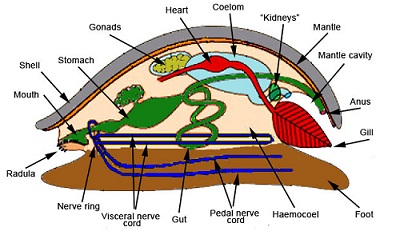Generalised Mollusc:
Despite the enormous diversity all of the living molluscs share a generalised design, however each taxa has modified aspects of that simplistic design to individualise itself. While no universal model of a generalised molluscan bauplan has been agreed upon, constructed is a bauplan which enables a starting point for which to build upon in relation to molluscan biology. Molluscs are portioned into sections including the poorly definedhead, visceral mass, shell and a ventral foot (Campbell & Dana, 2012).
 Figure 1: Diagram of Generalised Molluscan Bauplan (sourced from Marine Education Society of Australasia)
Figure 1: Diagram of Generalised Molluscan Bauplan (sourced from Marine Education Society of Australasia)
Shell:
The typical shell design of a generalised mollusc, is low, simple, with a conical cap covering the dorsum (Ruppert, Fox & Barnes,2004). The original shell probably originated by a thick cuticle of chitin and protein. Three basic shell layers are present within the molluscan shell, one organic and two calcareous.
Mantle Cavity:
The Mantle Cavity in Molluscs is a pocket which is enclosed by a dorsal peripheral out fold and a mantle skirt, this space is the central characteristic of the molluscan bauplan.
Gills:
The generalised mollusc has several pairs of gills, located in the mantle cavity (Ruppert, Fox & Barnes, 2004). However most modern molluscs usually only have one pair or, even only one gill. Typically the gills are feather like in structure, although some species of molluscs have filaments on a single side.
Osphradia:
Are sensory appendages present in the inhalant water current, these appendages are believed to monitor water quality and enable the organism to select environments which are suitable.
Foot:
A large muscular foot is an essential part of the generalised molluscan bauplan, with this organ occupying much of the ventral surface. Responsible for locomotion and attachment to substrate for an organism via the muscles extending from shell surface (Ruppert, Fox & Barnes, 2004).
Internal Transport:
Hemal System is main mechanism for internal transport as the coelom within molluscs is reduced (Ruppert, Fox & Barnes, 2004). System consists of a heart, dorsal aorta, blood vessels, blood (hemolymph - containing amebocytes and hemocyanin) and a hemocoel. This system can be described as ‘open’ thus arterial outflow and venous return are connected by large sinuses (Ruppert, Fox & Barnes, 2004). |